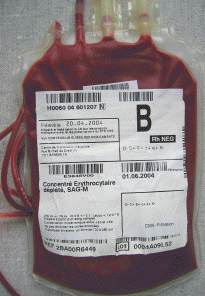Separation and storage of blood components
All types of donations (whole blood units, thrombapheresis units, plasmapheresis units) are now systematically depleted for leucocytes (whole blood by filtration, aphaeresis units by the aphaeresis apparatus itself or by filtration). Leukocytes are eliminated to avoid immunological side effects, to remove the cellular source of some viruses (like CMV) and prions, and to ameliorate blood conservation. After filtration, the whole blood donation is separated into several components: Packed red blood cellsPacked red blood cells from a donation of 450 ml of whole blood are obtained after centrifugation and plasma removal; the red cells are then suspended in a nutritive solution.
Fresh frozen plasmaFresh frozen plasma
is obtained after centrifugation of whole blood and red cell removal, or through direct separation (plasmapheresis). Because plasma can be stored for a long time, plasma is kept in quarantine until the donor comes back for a new donation so that he can be tested again for the infectious disease markers. This gives optimal security because (early) infections undetectable at the moment of donation have now become apparent.
Plasma can also be fractionated and processed into stable blood products, such as albumin, immunoglobulins, coagulation factors, ... PlateletsPlatelets are mainly obtained through thrombapheresis. Platelet products formerly obtained from a mix of more than 10 buffy coats can now be obtained from a single thrombapheresis of about 40 minutes.
|
|
|
Transplantation Immunology | |||||||||||||||||||
|
||||||||||||||||||||





 Print
Print